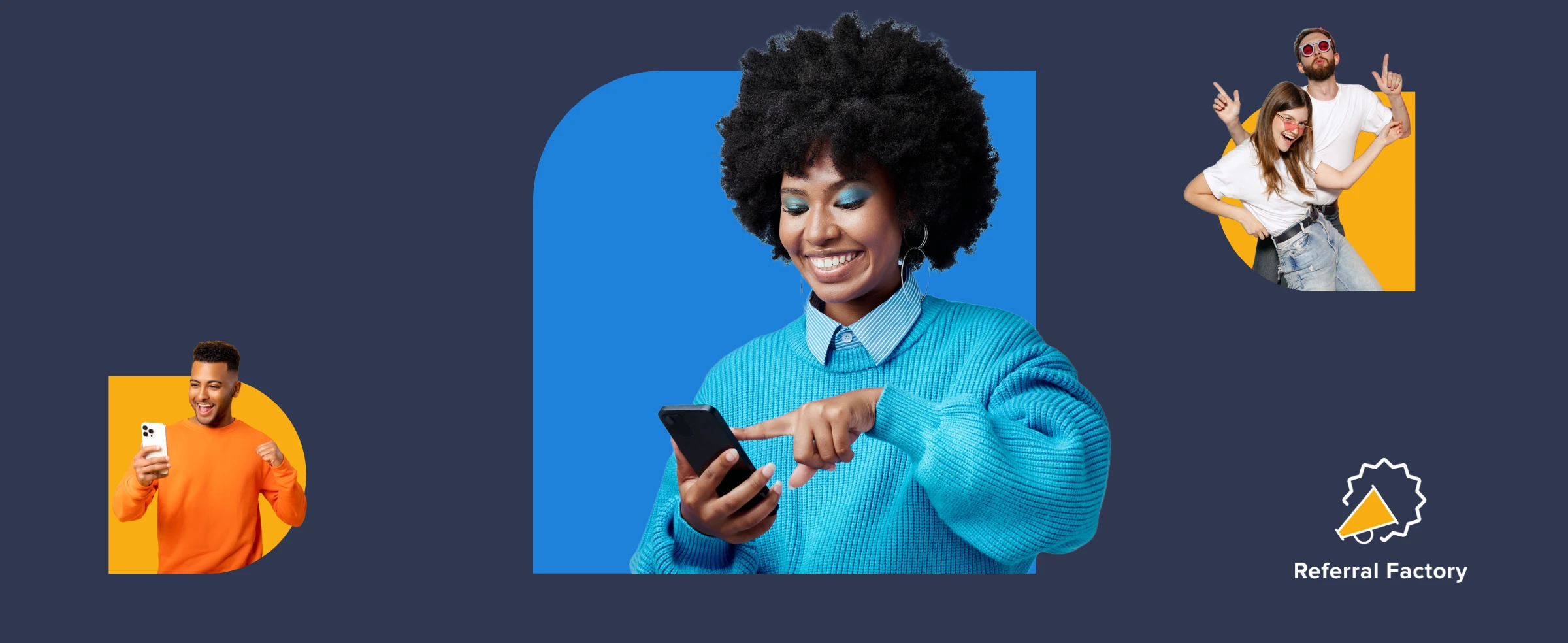Referral Program Best Practices: The Holy Grail of Referral Marketing
You may not believe it, but the key to skyrocketing your marketing performance could be hiding… in your customer base. Surprised? It doesn’t mean you have to hire your customers and fire your marketers. However, to improve your marketing practices ROI-wise, you just need to turn to referral program best practices.
Here’s the thing: if you review various marketing tactics to identify what truly works, you’ll be shocked that fancy modern marketing approaches don’t always bring the desired results. The majority of advertising methods are getting increasingly expensive and less effective, with consumers becoming numb to an endless stream of marketing messages.
Alas! So, what can you do to maximize the efficiency of your marketing strategy? The best way is to try a referral marketing program, aka word-of-mouth marketing. Since this marketing strategy is based on your current customers promoting your product or service, referral programs end up being:
- Highly efficient;
- Trustworthy;
- Cost-effective.
Keep reading to learn referral marketing best practices, discover great referral program examples, and find out how to properly use referral software to maximize your results!
Table of Contents
What Is a Referral Program?
A referral program is a simple way for a business to grow through word of mouth. It gives your customers, partners, or community a reason to share what they love about your product. When someone invites a friend and that friend becomes a customer, both sides can earn rewards like discounts, credits, or a small bonus. It’s an easy way to turn happy customers into your best marketers while building trust with new ones. You can even track every referral, see what’s working, and keep improving as you grow.
Why Do You Need Customer Referrals?
Let’s start by answering this simple question. Why, among many forms of marketing, should you choose a customer referral program? It’s simple: customer referrals are exceptionally valuable “assets” that are often acquired at minimal or even zero(!) cost for businesses.
At its core, a referral program incentivizes an existing customer (what we call the person referring) to recommend your product or service to their friends, family, and network (aka the person invited). When done right, customer referral programs can become a game-changer, driving significant growth and brand loyalty. In other words, you can extend your marketing team and use the power of your current customers to bring new ones.
The Benefits of Customer Referral Programs
A referral marketing program offers a multitude of benefits for businesses of all sizes. But what’s behind its effectiveness? How does a customer referral program work for so many different companies across all the niches? Here are some key reasons why a business would implement a referral program into its marketing strategy:
✅ Cost-effective customer acquisition
Compared to traditional advertising methods, a referral program offers a much lower cost per acquisition. Why? You only pay for customer referrals that convert, maximizing your return on investment. In other words, you don’t pay for the person invited (aka a referred friend) if they don’t perform the action you want them to perform (e.g., sign up for your newsletter, buy something from you, etc.).
When using virtually any other marketing channel, you would have to pay before any lead actually converts. But this isn’t the case with customer referrals. The bottom line is that most customer referral program ideas are very affordable and cost-efficient in comparison to other marketing approaches.
✅ Increased brand trust and credibility
Recommendations from trusted friends and family hold significant weight to consumers, and a customer referral program leverages this trust. It fosters a positive perception of your brand and increases your customer base. Besides, a referred customer is always more loyal because they tend to trust your business from the very beginning.
You could even go one step further and build a double-sided referral program to reap even more benefits. In this case, both the person referring and their referred friend (the person invited) get referral rewards. This approach is effective because of the reciprocity, as both people feel valued. But more on this later.
✅ No cold leads, only real customers
One of the biggest advantages of a refer-a-friend program is that you don’t just compile cold leads that don’t care about your product/service. You get new paying customers. There are many marketing channels that allow you to get new clients, but they usually come with high costs or quite complex funnels.
Because at the end of the day, you have to figure out how to walk your cold lead through all those stages of a sales funnel to actually sell. But with customer referral programs, you don’t have to care about it because your existing customers will basically do that job for you.
✅ More happy customers & higher customer lifetime value (CLV)
A referred customer is more likely to be satisfied with your product or service, as they already have a built-in high level of trust established by the person referring (their friend), which translates to higher customer lifetime value (CLV). Besides, an effective customer referral program can easily bring you clients who will stay with you for long.
✅ Customer loyalty boost
Referral programs reward existing customers for their advocacy, strengthening their relationships with your brand and increasing loyalty. Besides, new clients are often friends or family of existing customers. Thus, they are more prone to become loyal customers, especially if you keep showing them that they matter.
✅ Valuable customer insights generation
Referral programs can provide valuable data on customer acquisition channels and the demographics of your referred customers. This information can be used to refine your marketing efforts and target the right audience. Besides, such statistics can tell you a lot about your referral program’s performance: what exactly worked and what aspects you have to fix.
Referral Marketing Statistics
All those benefits above aren’t just us talking, the proof is in the referral marketing statistics. Let’s take a look at what has been happening in the referral market in recent years:
- Customers acquired through referrals have a 37% higher retention rate.
- Referred customers have a 16% higher lifetime value than non-referred customers.
- Referred leads are 2x more likely to convert than leads acquired through paid marketing channels.
- 84% of B2B decision-makers start their buying process with a referral.
Referrals alone can bring your business millions of dollars of revenue, as this solar referral program case study proves.

Referral Program Best Practices for Your Business
The importance and efficiency of referral marketing are hard to deny. But, how can you maximize the results of your referral programs? That’s right, you should turn to the best practices! Let’s see some of the most effective customer referral program ideas to make your campaign visible and successful.
Offer Dual-Sided Rewards
Creating double-sided referral programs is rule number one. Don’t dangle a carrot in front of existing customers only. After all, you want to acquire new customers! Offer an enticing welcome gift for referred friends, too. When referral incentives go two ways, you create a win-win scenario that boosts your referral program engagement. This way, referral program members can spread the word even further because they feel better as everyone gets some benefits.
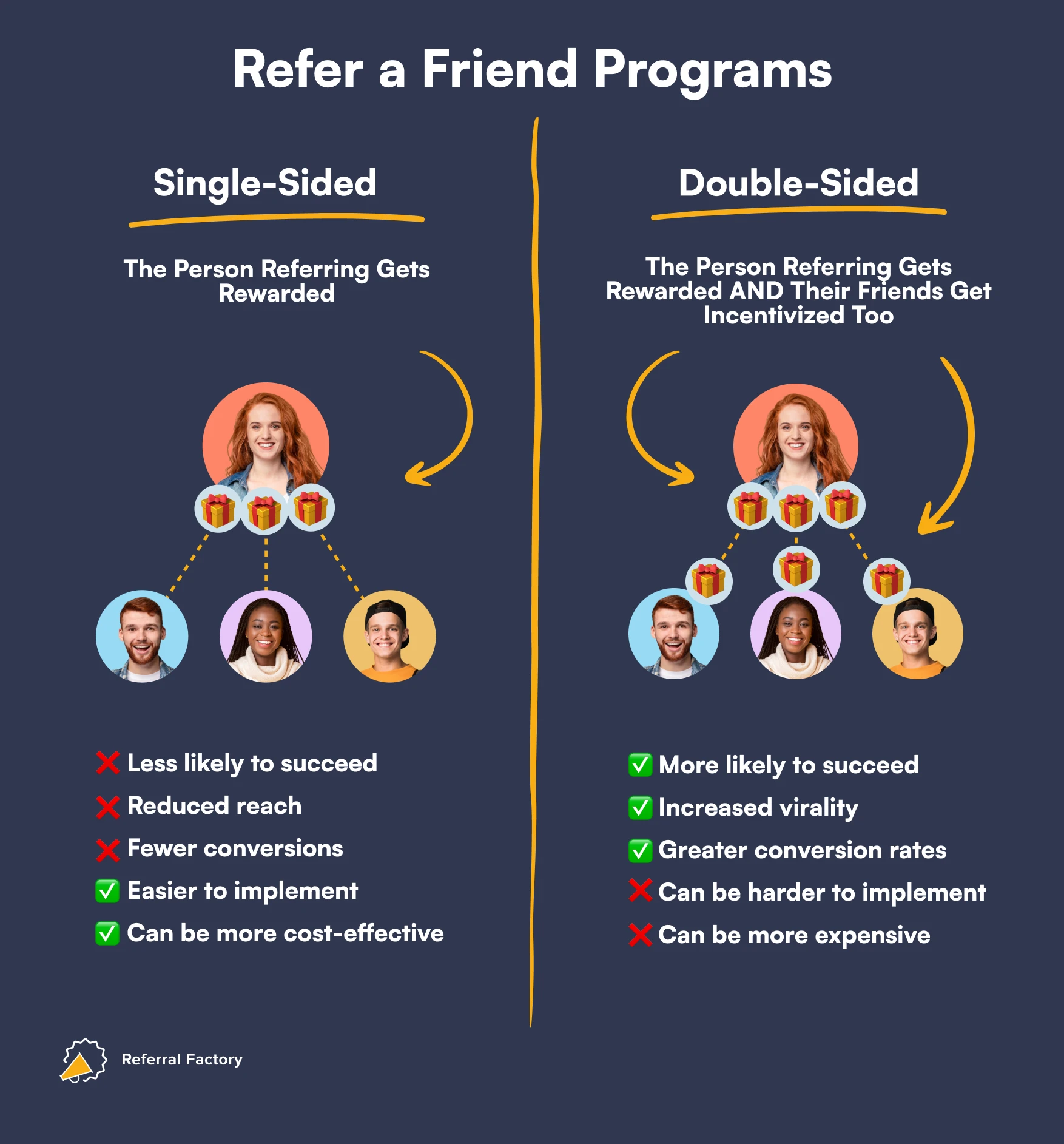
Maybe you’ve thought, “Hey, it feels a little strange to ask friends and family for favors.” That’s totally fair! But here’s the best part: referral programs are all about give-and-take. Your existing customer refers your business and, at the same time, helps their loved ones score something awesome (your referral rewards). This is how a refer-a-friend campaign turns into a pleasant experience for everyone.
Here’s an example of how it works. FreeAgent is online accounting software made specifically for freelancers, small business owners, and their accountants. Every person who subscribes to FreeAgent using a unique referral link will get a 30-day free trial. If they subscribe at the end of their trial, both the person referring and the person invited earn 10% off subscriptions for as long as they remain subscribed (i.e., forever).
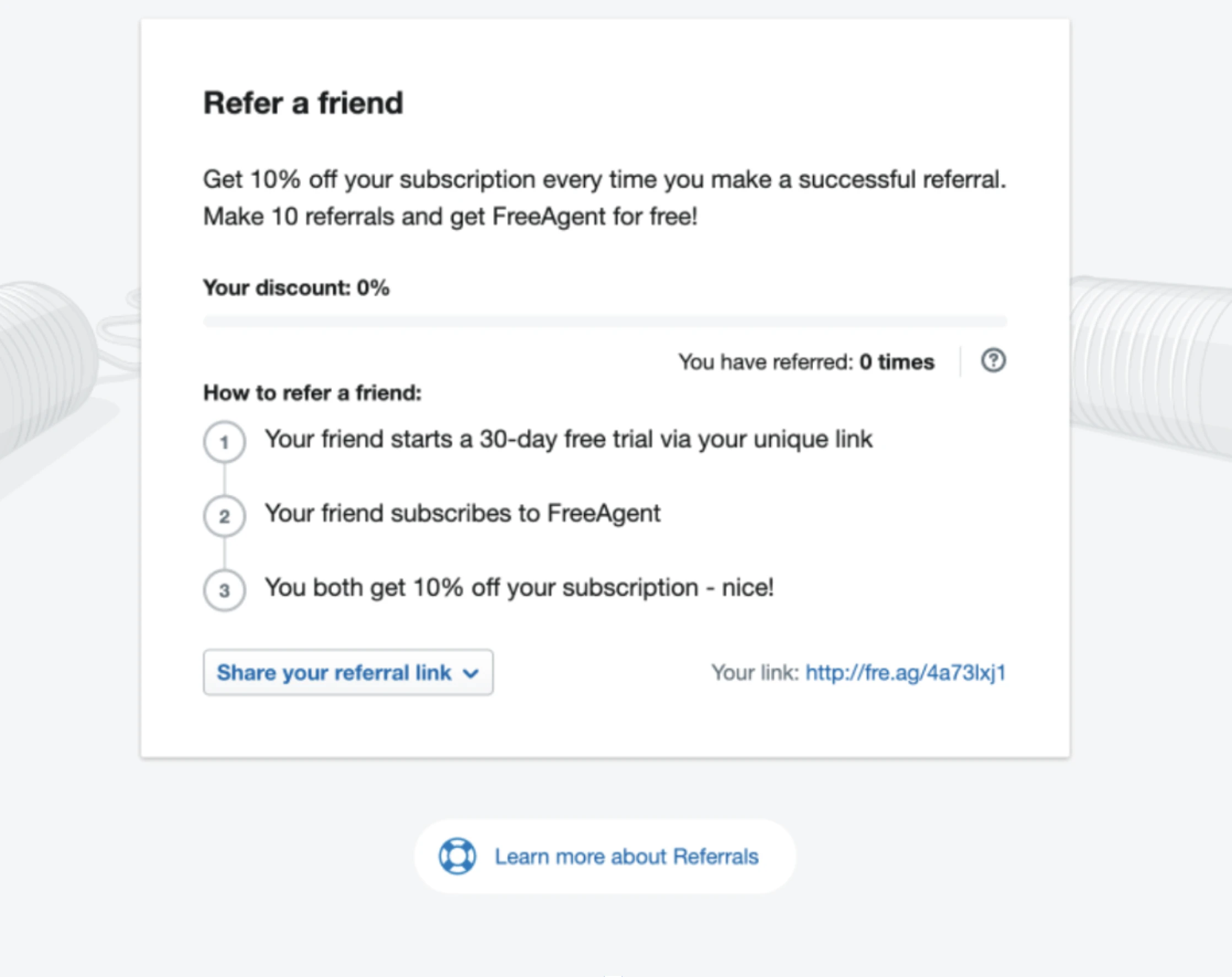
💡 Tip: Even if you started with a single reward only for your current customers, it’s not a problem. You can always update your referral program and add double-sided incentives.
Define Your Ideal Customer
This is one of the fundamental referral marketing best practices. Before you encourage customers to refer, you should define who an ideal client is for your company. Clearly outlining the criteria should be your priority. For instance, if you use a referral form, display what qualifies as a “good fit” customer at the top.
Take this Revolut <18 referral program, for example. Right in the hero section of their landing page, they mention “Revolut <18” three times to highlight that they refer to their teenage (under 18) program.
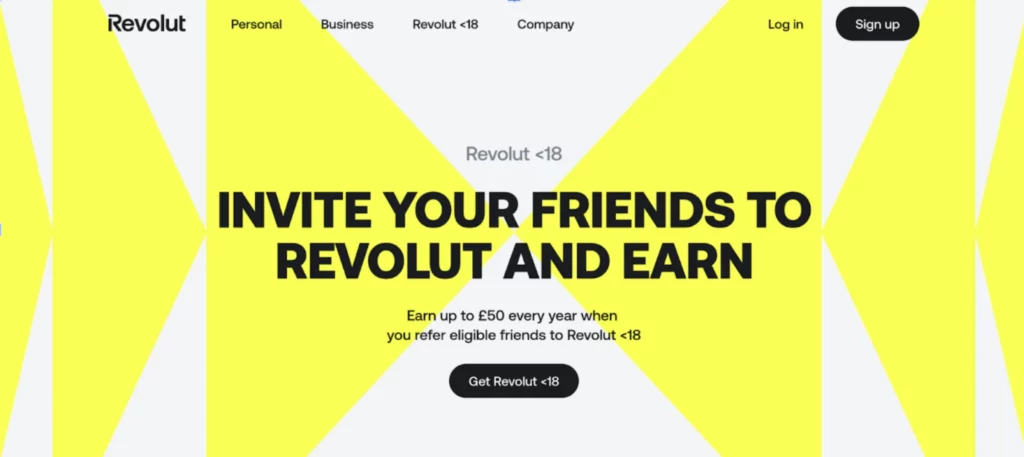
The following section specifies the exact steps a referral program participant should take in order to earn their referral reward. In addition, they explain the age limit for this referral program.
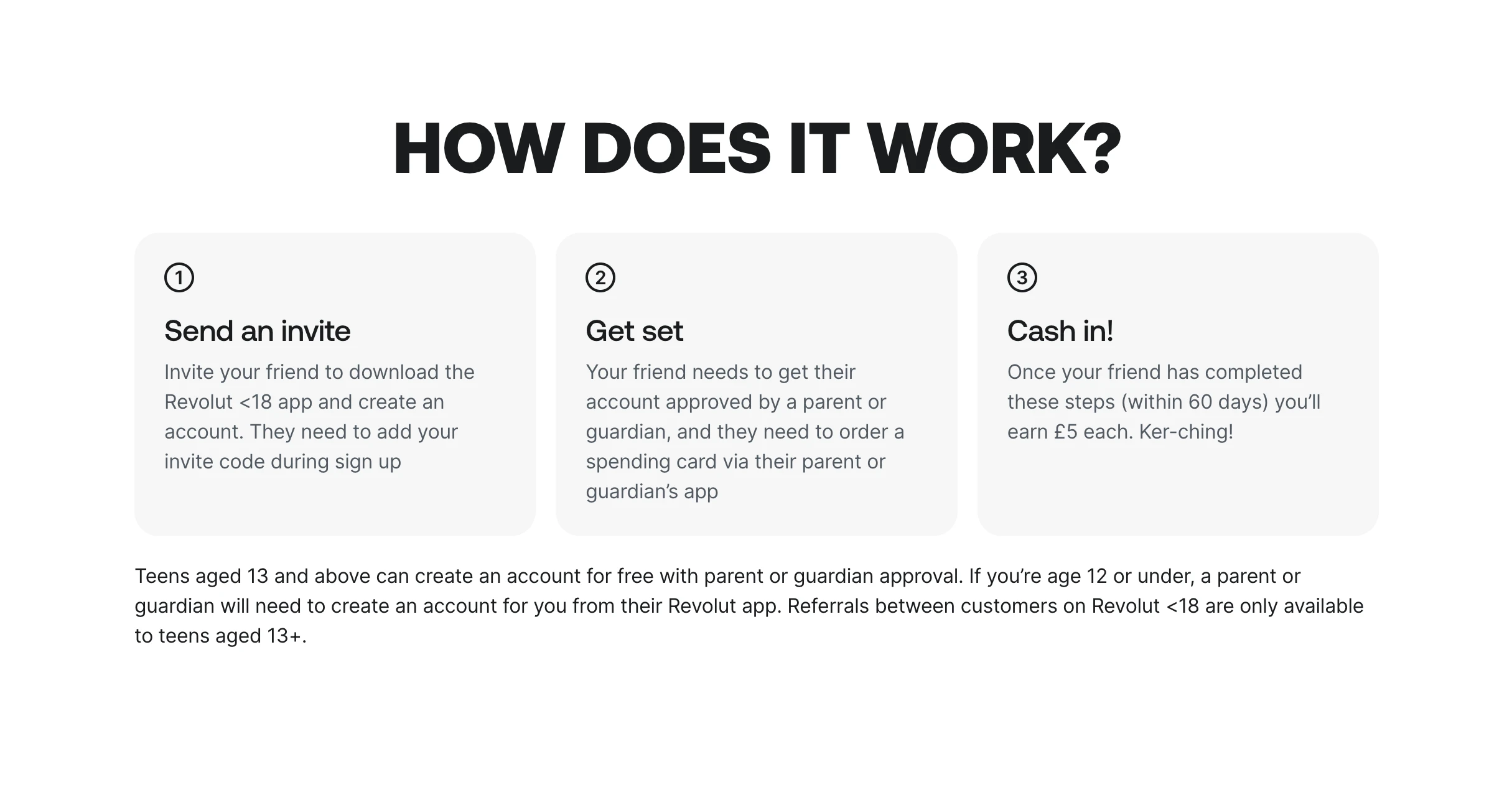
This serves as a constant reminder to referral program participants that you focus on identifying people who genuinely require your product or service rather than simply recommending friends who might have a passing interest. It’s like a map for referring customers.
Now, how do you define your ideal customer? Here are the essential steps you should take.
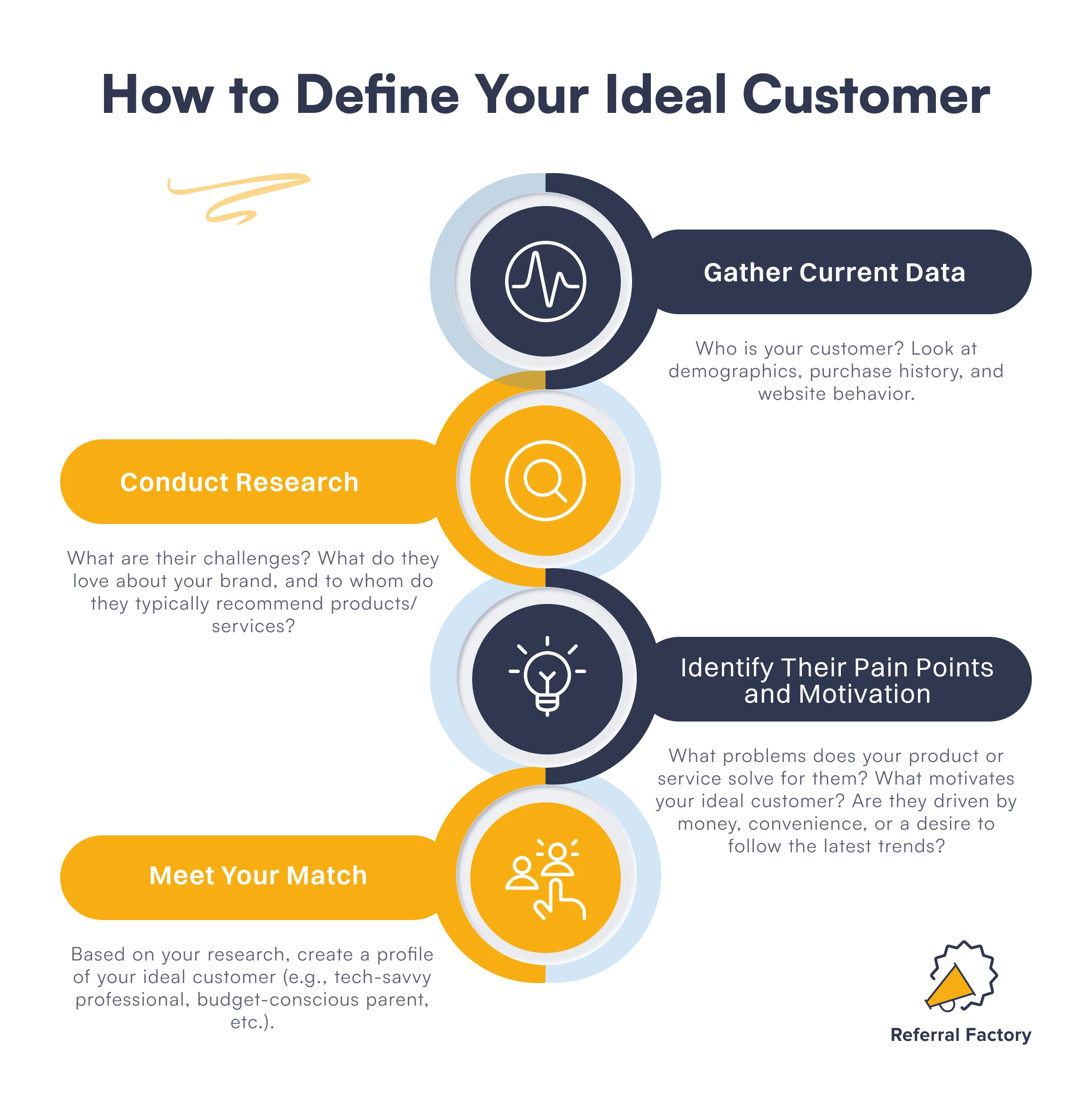
1️⃣ Gather Current Data. Who are your current customers? Look at demographics, purchase history, and website behavior.
2️⃣ Conduct Research. What are your clients’ challenges? What do they love about your brand, and to whom do they typically recommend products and services?
3️⃣ Identify Their Pain Points and Motivation. What problems does your product or service solve for your clients? What motivates your ideal customer? Are they driven by money, convenience, or a desire to follow the latest trends?
4️⃣ Meet Your Match. Based on your research, create a profile of your ideal person invited (e.g., tech-savvy professional, budget-conscious parent, etc.).
Understanding your ideal customer is also essential to defining what referral rewards will work the best. You can reward your referral program participants with store credit, vouchers, cash, discounts, etc. Which one is better for your business? You have to know your clients to understand that.
Keep the Referral Process Simple
A successful referral marketing program should be simple from head to toe. Why? Because people won’t spend ages figuring out complicated terms. That’s why both your referral program messaging and the sign-up process should be fast, simple, and intuitive.
Let’s analyze the Dropbox referral campaign. Their referral program’s landing page has 2 main sections – a hero section with a title and 2 lines of text and an FAQ section. That’s it! Simple and sweet.
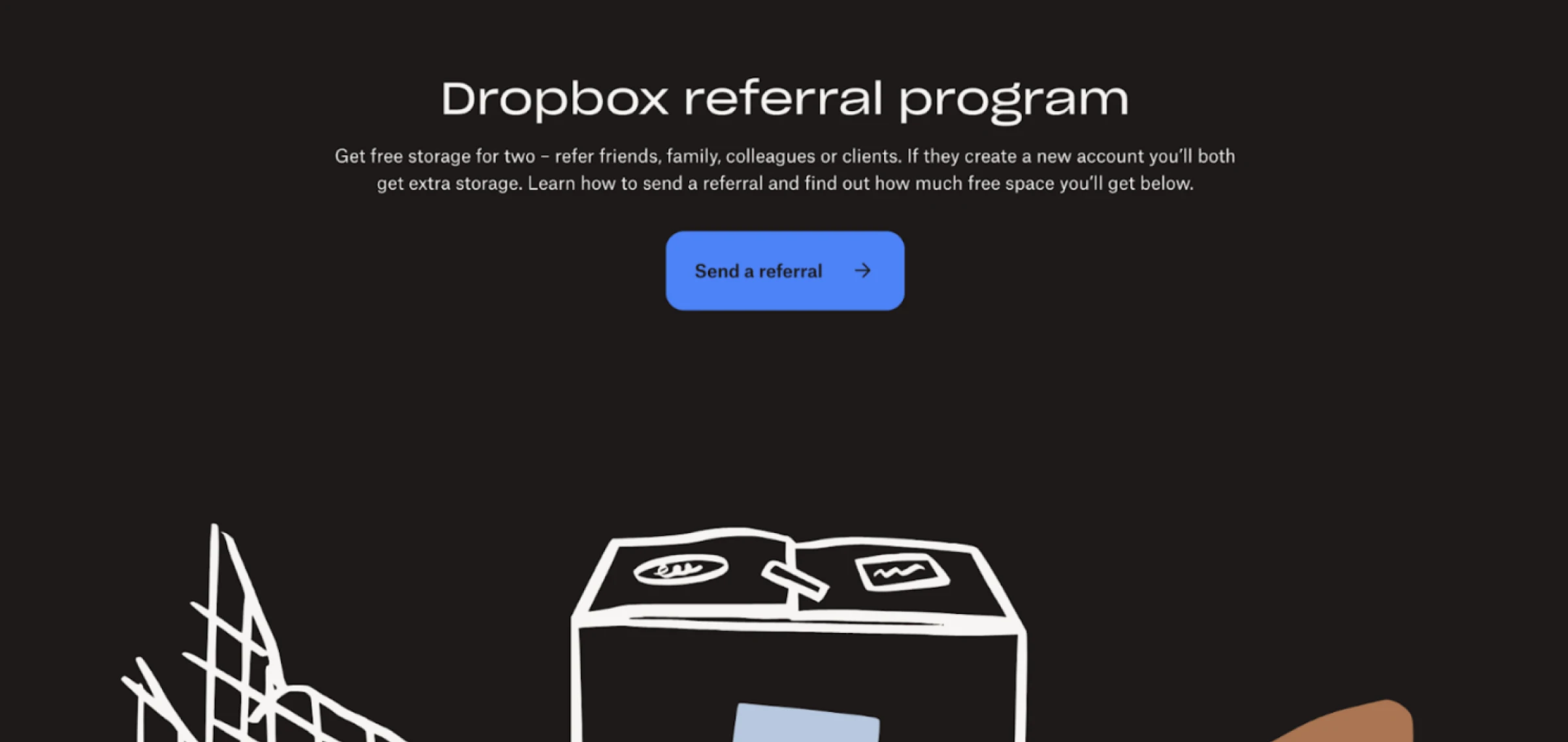
In addition, the signup process takes less than a minute with only a few clicks, which is another crucial element for a successful referral program.
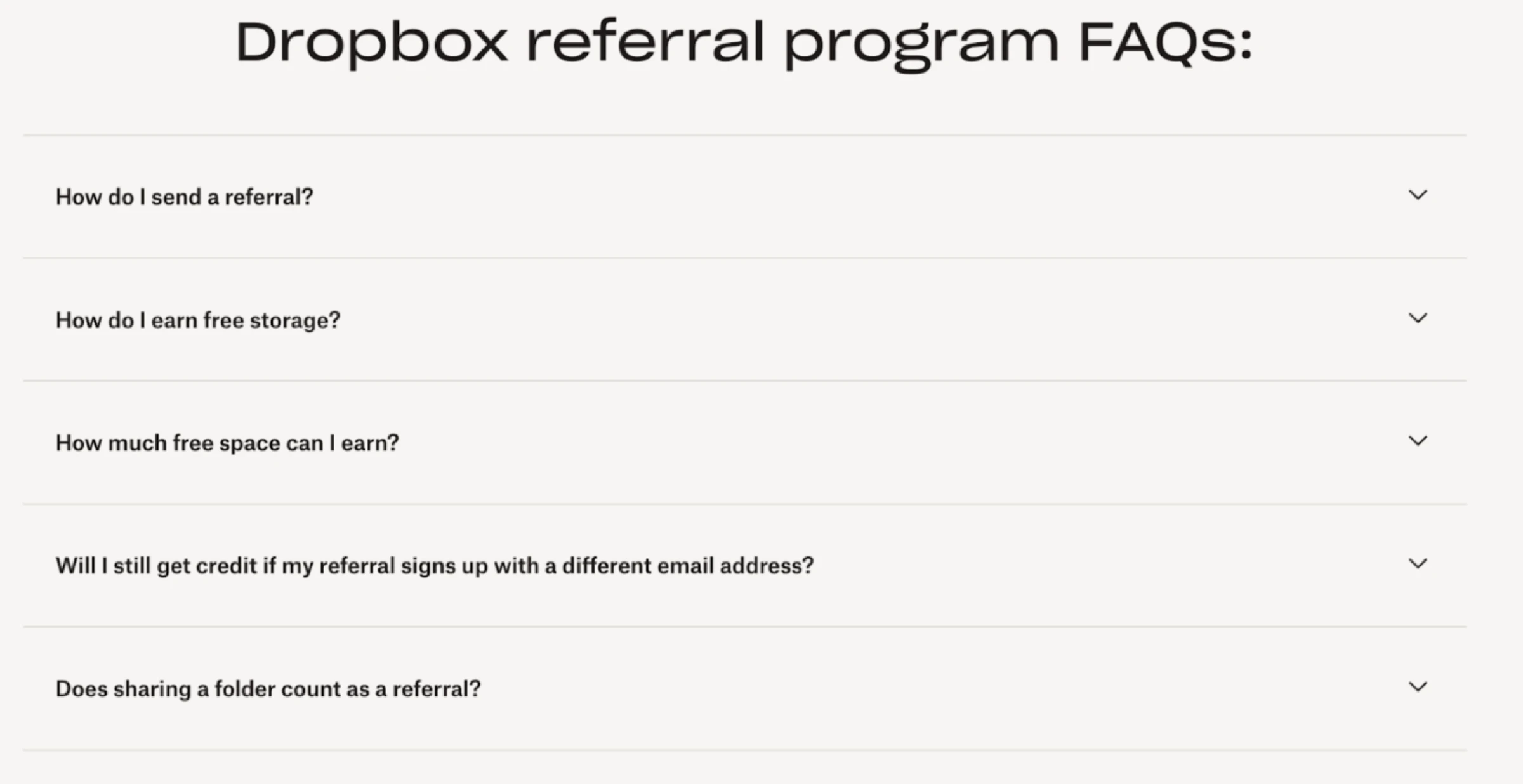
Dropbox’s referral program is an excellent example thanks to its simplicity and double-sided rewards, Dropbox saw massive business growth — 3900% in just 15 months. This case shows how a strong customer referral program can boost a company’s evolution.
Understand How People Discover and Join Referral Programs
Researching the origin and flow of referrals to your business is vital. A good starting point is evaluating whether referrals are reaching your business easily and through what channels they do it. Engage colleagues from marketing, sales management, and customer support. All of them play pivotal roles in nurturing customer relationships, and you cannot create a successful program without them.
Examine your clients’ traditional refer-a-friend methods and gain insight into your current standing. If you simply know how you got your existing customers or where you lost potential happy customers, you’ll be able to make a new referral program work flawlessly.
The path a customer takes from initial awareness to brand loyalty is what makes the customer journey. Understanding this journey is crucial for any successful marketing strategy, and referral marketing is no exception. That’s why mapping a customer journey is a must if you haven’t done it yet.
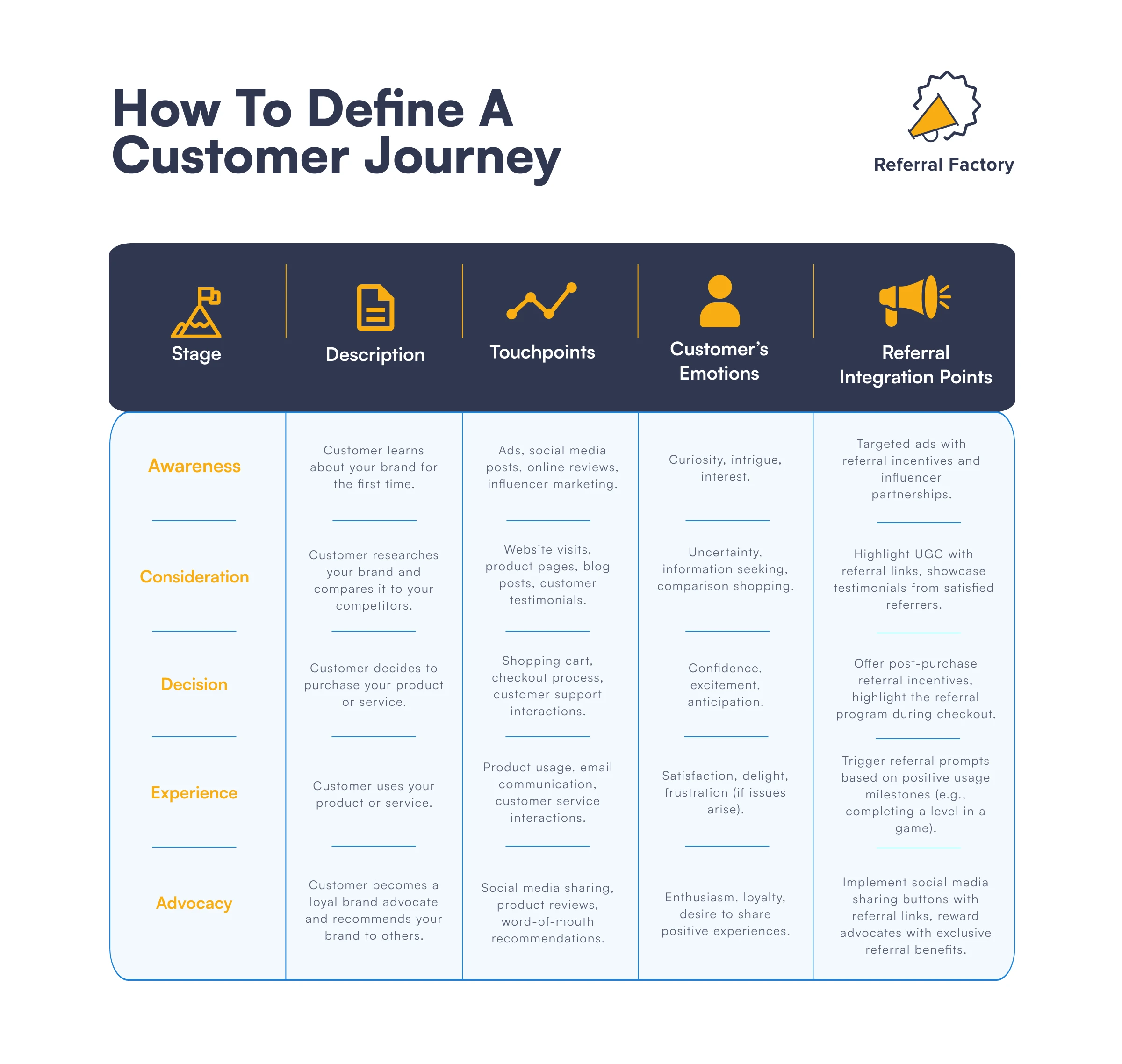
Once a customer makes the first purchase, make sure to support their interest. Use other marketing channels and stick to your funnel. If you have good referral program software, you’ll easily find out who invited whom and how people learned about your program. With proper analytics, you can improve your referral marketing strategy later and increase customer retention.
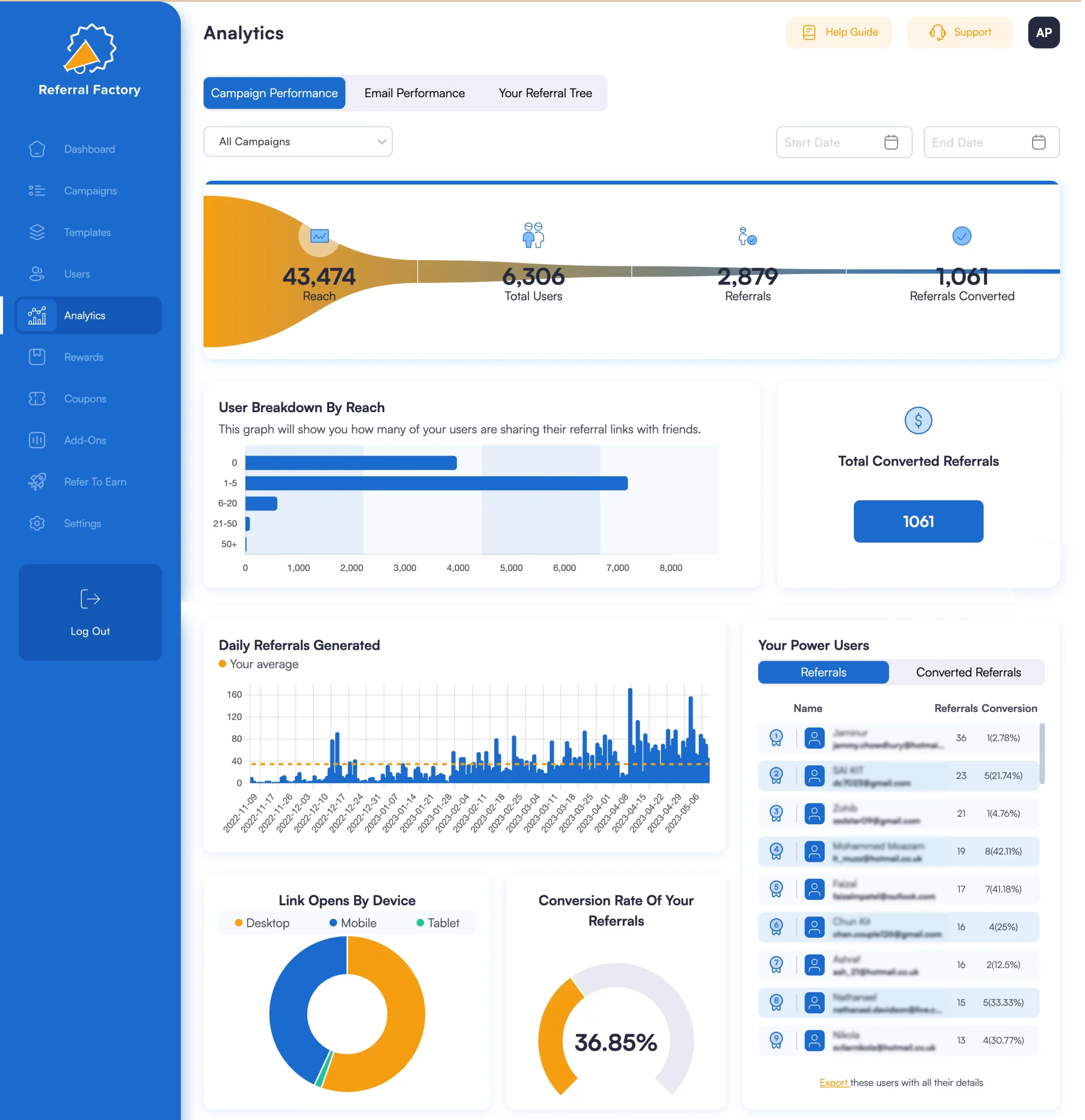
Promote Your Referral Program Across Multiple Channels
Once you’ve set up your referral program, it’s time to let your customers know about it. Promotion is key! Think about what resources would be effective, and then spread the word through various channels. The more, the better! So, don’t just rely on one-time emails; consider ongoing methods like newsletters, blogs, email signatures, and product updates to keep reminding your existing customer about the program.
Here are the additional ideas you can use:
✅ Customized emails for different types of contacts to inform them about your referral program.
✅ A clear message explaining the types of prospective customers who are a good fit for your business. Help persons referring understand your ideal customer.
✅ A step-by-step workflow to guide contacts through the referral program and alert your sales team when to reach out.
✅ Scripts for your sales and customer support teams to explain how the referral program works.
✅ If you have your clients rate your business highly in any survey, send them information about your referral program.
Of course, there is more. Every business is different, and the way to inform your referrals could be completely unique. Whatever medium you choose, ensure it’s consistent, not too pushy, and aligned with your program’s goals for revenue, growth, and customer retention. Keep the message persistent but not overwhelming. You don’t want to seem spammy or needy, so make sure your communication is easy and light.
Start Small, Then Expand Your Audience
It’s hard to talk about referral marketing best practices without mentioning the audience you should actually target. You’ve probably got different groups of people you want to reach. And there are quite a few options for you to get there. You can tap into your existing customer base or ask your business partners and employees to join your referral program.
You can create several campaigns and tailor them to different audiences. But if you’re new to the whole referral marketing thing, start with your clients. Why? They already know and love your brand, which makes them a perfect test group to see which rewards and messages work best. Once you’ve got that, you can branch out and create additional campaigns to target other audience segments. And it doesn’t have to be only your employees or business partners. Here are some additional examples:
🤗 Loyal customers. This is your best audience. Reward your brand advocates with exclusive incentives for referring new customers.
🙂 New customers. Welcome newbies with a referral campaign that offers them a discount or bonus for referring a friend, incentivizing them to try your product or service while spreading the word. Of course, they aren’t as dedicated to your brand as loyal customers, but you can still motivate them with proper referral rewards and a strong brand voice.
🏜️ Location-specific targeting. Do you have a strong local presence? If so, use it. Design a referral campaign targeted at a specific region. Offer discounts or partner with local businesses for cross-promotional opportunities. It is a great way to strengthen your position in a particular location. Besides, you can run several referral programs like this in different regions simultaneously.
👭 Demographic targeting. If your product/service line is diverse, don’t hesitate to create several referral programs for each demographic group. But this will greatly depend on your referral marketing strategy because you might not need multiple campaigns for different demographics.
You might want to list all the potential referrals for your business. It can be anyone who used to have contact with you, including current customers, past customers, leads that didn’t convert, industry leaders, and even your vendors.
By assembling this diverse array of contacts, you establish a sturdy foundation to kickstart your referral marketing strategy. Your referral program design will depend on how far you try to reach, so make sure to know all of your possible audiences.
Choose Reliable Referral Software
At the so-called back-end of any successful referral program, there is referral program software. Why do you need it? The simple truth is that without it, crafting your whole referral program would be much harder, especially if you have more than 50 people to ask to refer. The reasons for that are solid. With proper referral marketing software, you can:
- Track every step of your referral process;
- See who referred whom and when;
- Check how many clicks the referral link gets (especially helpful for an influencer referral program);
- Find out who converted and who still needs to be converted.
When choosing software for your referral marketing efforts, make sure it is intuitive, cost-effective, and has several integrations. In the end, you want to reward customers quickly and keep an eye on your referral traffic. Choosing the right tool is one of the fundamental referral marketing best practices.
Besides, choose referral software that operates with referral links rather than codes. This way, it is easier to spread the word about your refer-a-friend campaign, which will definitely maximize your results.
As long as customers can find your referral link, they will be able to start sharing it with others. This is the benefit of a good referral software for businesses.
💡 Pro tip: If you have a customer portal or any type of logged-in space for your customers, make sure to add a unique referral link there, thus, it’s easier to find.
The beauty of referral marketing is that it allows you to run multiple campaigns simultaneously. Each campaign can be customized with its own messaging and incentives while you conveniently track the performance in one central location (your referral software). Besides, on each referral program page, you will see all the necessary metrics to evaluate whether your refer-a-friend campaign requires any tweaks.
Below is an example of a place from which you can rule them all 🙂
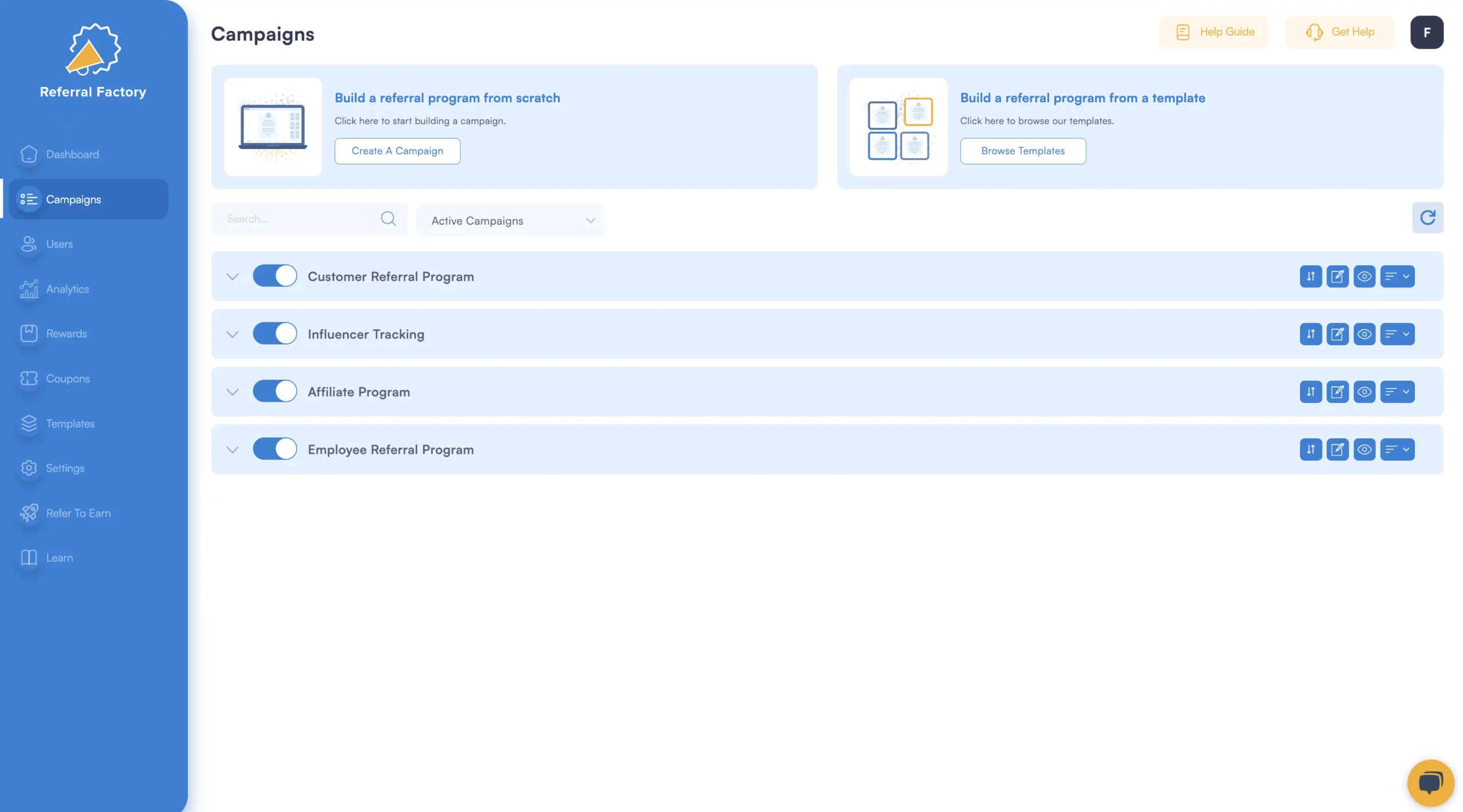
Many teams also ask if referral programs work the same way as affiliate programs. They don’t. The difference between affiliate and referral marketing is simple: referrals rely on personal relationships (your customers recommending you to people they know), while affiliate marketing is driven by external partners promoting your brand to wider audiences for commission. Because referral marketing relies on existing relationships, it usually requires simpler software and lighter incentives than affiliate programs.
Refer-a-Friend Platforms
Once your referral software is in place, the next step is making participation simple for your customers. That’s where refer-a-friend platforms come to play.
These platforms are designed to make sharing second nature. They provide ready-to-use referral pages, built-in sharing buttons, and simple reward delivery, so your customers can invite friends with just a few taps. The easier it is to share, the more likely people are to do it.
Many of these tools also support mobile-first sharing or in-app rewards, following app referral program best practices that make it easy for users to invite friends right from their phones.
Before listing the specific platforms, it’s worth looking at another small but powerful tool that can instantly boost participation, the referral marketing widget.
Referral Marketing Widget
Adding a referral widget to your website is one of those small changes that can make a big difference. When people see a simple “Refer a Friend” box right where they already interact with your product, on a dashboard, checkout page, or user profile, they’re far more likely to take action. It removes friction by keeping the referral process in context.
Customers don’t have to search for a link or open another page; sharing happens naturally as part of what they’re already doing.
For SaaS companies, this approach aligns with SaaS referral program best practices. Embedding the widget directly inside the product allows the users to refer others at the perfect moment, right after they’ve completed something meaningful or experienced value.
In other words, imagine finishing a successful project on a platform and immediately spotting a small “Invite a friend and earn credit” prompt. If you have a friend in mind who’s working on a similar project, of course you’d want to share the platform with them too.
The referral process feels like a natural part of the experience, which is exactly why widgets drive higher participation and better conversion rates.
How Effective Are Referral Programs?
Referral programs consistently outperform most paid channels when it comes to both trust and cost. Here are some key stats:
- Referred customers have a 37% higher retention rate than non-referred customers
- Referred leads are 2x more likely to convert than leads from paid marketing channels
- Referred customers have a 16% higher lifetime value than non-referred customers
- 84% of B2B decision-makers start their buying process with a referral
These numbers show that referrals not only bring in more customers but also the right kind of customers, who are loyal, engaged, and more likely to spend over time.
Referral Program Marketing: Examples of Success
You can build a referral partner program for almost any business, from automotive brands to tech startups. Across every industry, companies have found creative ways to turn happy customers into active promoters. The key lies in designing programs that feel rewarding, effortless, and true to the brand experience.
How does the Tesla referral program work?
Tesla’s referral program encouraged owners to invite friends to buy a vehicle. The goal was to reward both referrers and new buyers while boosting Tesla’s reach without traditional advertising.
How it worked:
Each Tesla owner received a unique referral link. When a friend used the link to purchase a vehicle, both the owner and the new buyer earned rewards, such as free Supercharging miles or entries into exclusive events.
Why it worked:
Tesla’s program followed the principle of double-sided rewards and made sharing easy. By integrating incentives that felt valuable and timely, they turned existing customers into active promoters and tapped into a network of highly motivated advocates.
How does the Evernote referral program work?
Evernote wanted to grow its user base while keeping acquisition costs low. Their referral program gave current users a reason to invite friends to try the app, helping expand the audience organically.
How it worked:
Users received a referral link to share. Each time a friend signed up, the referrer earned extra storage space, and the new user got a bonus as well. This system encouraged sharing while keeping the reward relevant to the product experience.
Why it worked:
Evernote’s success came from making the referral process simple and integrated into the app. Users could share with one click, and rewards were meaningful for both sides, following best practices like timely, in-context incentives and easy participation.
How Referral Factory Adds Value to Your Referral Program
Running a referral program that actually performs takes the right mix of strategy and software. While the strategy is on you, Referral Factory can take care of the software side with ease.
It puts your referral program best practices into action by giving you the tools to launch, manage, and scale your referral campaigns.
Overall, it’s main goal is to remove the guesswork and manual effort, so you can focus on growing your customer base while the platform handles the rest.
Here are some of the key features:
Unified Tracking and Management
Centralizing all referral activity gives you complete visibility into who referred whom, where signups came from, and how rewards are flowing. You can run multiple campaigns in one dashboard, making it easy to monitor performance, adjust messaging, or test different incentives. Everything lives in one place, so managing your referral program feels straightforward rather than scattered across spreadsheets and tools.
Fraud Prevention and Data Security
Referral Factory includes built-in safeguards that prevent fake signups, duplicate referrals, and suspicious activity. This protects the integrity of your program and ensures that rewards go to legitimate participants. Both referrers and new customers can trust the process, which encourages more sharing and reduces the risk of disputes or errors.
Scalable Partner Management
The platform makes it easy to grow your referral network. You can add new partners or affiliates, set consistent incentives, and manage multiple campaigns simultaneously. Scaling your program does not add complexity because Referral Factory keeps all partners and campaigns organized in one place.
Real-Time Analytics and Optimization Tools
Referral Factory provides performance data in real time so teams can see clicks, conversions, and ROI. This allows you to test different rewards, refine messaging, and optimize campaigns quickly. Insights from analytics help improve results without guesswork, making each program iteration more effective than the last.
Compliance Made Simple
The platform helps keep your referral programs compliant with data protection and reward regulations. Teams can reduce administrative work and avoid mistakes because program rules, data handling, and reward tracking are built into the system. Compliance is easier to manage, giving your team confidence that the program runs fairly and legally.
What To Do Next
Improving or starting a referral program doesn’t have to feel overwhelming. The key is taking structured steps that focus on visibility and iteration.
Here’s a practical roadmap you can follow to make your program to make your program expandable and sustainable.
Audit Your Current Program
Start by taking a close look at your existing referral setup. Identify what’s working and what isn’t. Check whether people are actively sharing their links or codes and note where referrals tend to drop off in the process.
Review metrics like clicks, signups, and completed rewards. Even if you don’t have a formal referral program yet, analyzing customer behavior, past promotions, or informal word-of-mouth can reveal opportunities. The goal is to understand the current landscape so you can build improvements on solid ground.
Define Measurable Goals
After identifying your starting point, set clear targets for your referral program. Define what success looks like by outlining specific metrics such as new signups, revenue generated, conversion rates, retention improvements, or increases in customer lifetime value.
Each goal should be measurable and easy to track. Clear objectives make it easier to evaluate performance and guide decisions on incentives, messaging, and targeting. Measurable goals also show whether your efforts are delivering real results.
Integrate Tracking and Automation
Manual tracking can slow you down and create errors. Add tools or software that automatically handle tracking, reward fulfillment, and reporting.
Platforms like Referral Factory centralize these tasks so you can see every referral, reward, and conversion in one dashboard. Automation reduces administrative work, keeps rewards accurate, and lets you focus on growing your program instead of fixing mistakes. Proper tracking also ensures you capture insights that are critical for future optimization.
Experiment and Optimize Continuously
Even small adjustments can have a big impact. Test different rewards, messaging, or sharing flows to see what resonates with your audience. Try A/B testing referral emails, landing page layouts, or call-to-action wording.
Analyze which tactics drive higher engagement and conversion, then iterate based on the results. Continuous experimentation keeps your program fresh and ensures you are always improving the customer experience while maximizing referrals.
Scale Across Channels
When your referral program starts showing results, look for ways to expand it. Extend it to new audiences, additional products, or different regions. Involve partners, affiliates, or employee advocates to broaden your reach.
Growth amplifies the impact of a strong referral foundation and generates more measurable results. Keep campaigns consistent but tailor them slightly for each new channel to stay relevant.
See How Far Referrals Can Take You
Now, you’re equipped with the knowledge necessary for crafting a winning referral program. Use these referral program best practices, and remember, the key is to make it a win-win situation for both your existing customers and the new ones. It is a great way to bring in more referrals. In the end, people stick to those brands who value them as customers.


